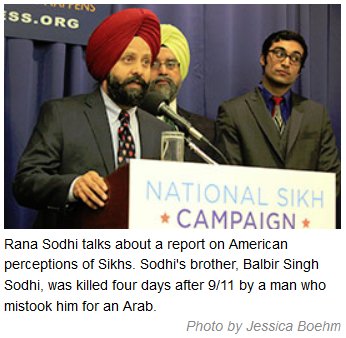|
Highlights of the report "Sikhism in the United States: What Americans know and need to know," was based on three focus groups of white Americans with varying levels of education and on a nationwide online survey of 1,144 non-Asian Americans. Among its findings: • 60 percent of Americans know nothing about Sikh Americans. |
The shooting came just days after the 9/11 attacks by a gunman seeking revenge. Balbir Singh Sodhi, a Sikh man in the religion’s traditional turban, became one of the first victims of the hate crimes against immigrants that followed that attack – but he was not an Arab, or even from the Middle East.
“You are in pain when you lose a loved one, always,” Rana Sodhi said Monday. “But you are more in pain when you lose a loved one with hate.”
Sodhi said he has made it his “life mission” to educate people about his faith and values and was in Washington for the release of a report on American awareness of and attitudes toward Sikhs.
The report, “Sikhism in the United States: What Americans know and need to know,” found that “most Americans know little to nothing about Sikh Americans and some even feel uncertain or anxious upon seeing Sikhs.”
Gurwin Singh Ahuja, co-founder of National Sikh Campaign that commissioned the report, said at a news conference for its release that Sikhs have had difficulties communicating their values because of misconceptions about their appearance. Sikh men are traditionally bearded and wear their hair in a turban.
 “What’s tragic is that we hold incredibly progressive values,” Ahuja said. “Sikhs believe that men and women are equal – that all faiths should have the right to practice.”
“What’s tragic is that we hold incredibly progressive values,” Ahuja said. “Sikhs believe that men and women are equal – that all faiths should have the right to practice.”
While it found Americans have limited knowledge of Sikhism, the report also found “enormous potential to enhance positive feelings toward Sikh Americans.” It said Americans are largely a “blank slate” when it comes to the religion and that they respond positively when educated about Sikh values.
Ahuja said he hopes that through education, young Sikhs will be able to tie their turbans and know that it is “a symbol of respect for all humanity, not just an object of inevitable discrimination.”
The report also said younger Americans, those in the millennial generation, are particularly responsive to learning more about Sikh Americans, something Sodhi has seen during his work in Arizona.
About six months ago, Sodhi gave a speech to nearly 1,000 high school students at Dobson High School in Mesa.
“I was impressed with the younger generation,” Sodhi said. “They listened to my story. I feel like my story is working.”
 Sodhi said the people he knows in Arizona have given him the strength to tell his brother’s story and educate in order to curb ignorance about his religion.
Sodhi said the people he knows in Arizona have given him the strength to tell his brother’s story and educate in order to curb ignorance about his religion.
“That’s the love and encouragement that’s in my community in Arizona,” Sodhi said.
Jaswant Singh Sachdev, a Sikh doctor from Phoenix who has worked with Sodhi’s family since Balbir Singh Sodhi’s slaying, also attended the news conference. Sachdev said that the Sikh community in Phoenix is small – just over 10,000 people – but that the greater community has become more aware of Sikh values because of their education efforts.
“We have made this (the) purpose of our life … to let even one person know as to who we are and what our faith means,” Sachdev said. “Not necessarily talking about faith, but as Americans, as the right to be what you want to be so long as you do the things that the Constitution expects of us.”
It’s the small successes he has had in his community, coupled with his brother’s memory, that drive Rana Sodhi to keep sharing his story.
“I feel like my life is worth (it) if I can educate a single person in a single day,” he said.

